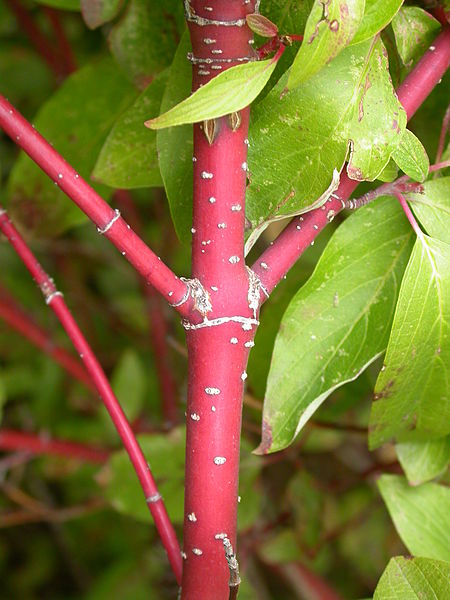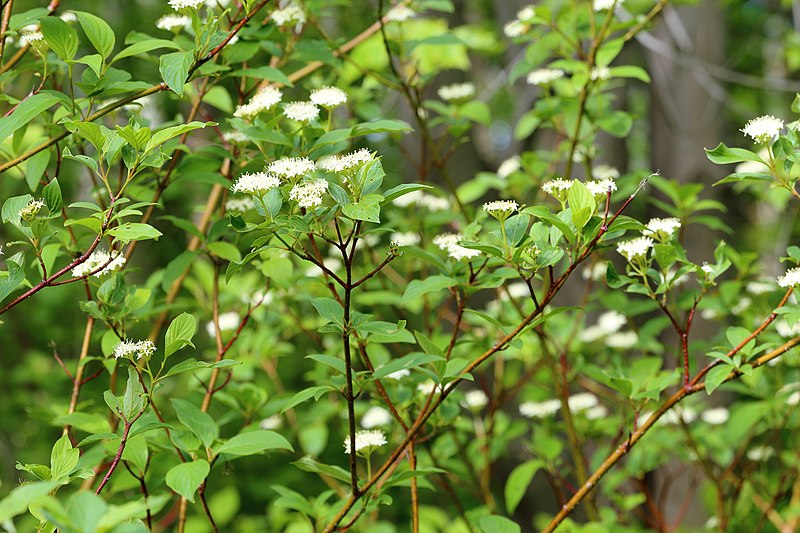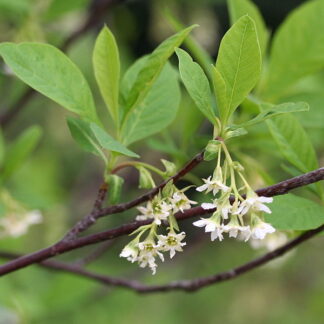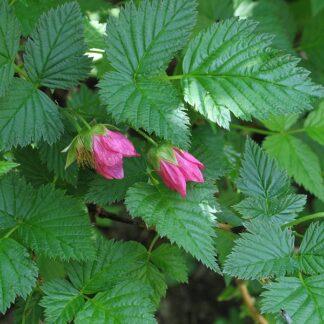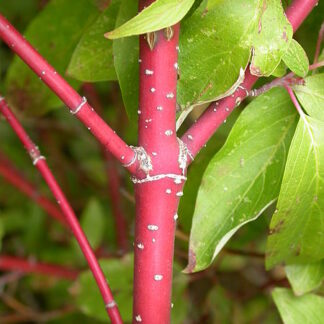Description
Cut stakes sold in bundles of 10.
At a Glance: Spreading, thicket-forming shrub with bright red stems.
Height: Up to 20 feet (6 meters).
Growth Form: Shrub.
Stems: Bright red, smooth stems; opposite branches; branches can root freely.
Leaves: Opposite arrangement; oval, sharp-pointed with 5-7 prominent parallel veins that converge at leaf tips; filmy white threads running through veins; leaves can become reddish in autumn; size: 5-10 cm (2-4 in) long.
Flowers: The tiny flowers have 4 petals and 4 stamens; numerous in dense, flat-topped terminal clusters; primary color: white to greenish; size: 2-4 mm long.
Flowering Period: April, May, June.
Fruits: Berry-like drupes ranging from pale bluish-green to white in color, each with some flattened stones; bitter and inedible; size: 7-9 mm long.
Appeal: Red Osier Dogwood has become a popular ornamental species. The red stems provide striking winter interest, and its clusters of small white flowers are showy in spring. The clusters of white berries provide color in late summer, and the leaves turn reddish in the fall.
Conservation Uses: Red Osier Dogwood has long been used as a restoration species, as well as an ornamental. Its dense, matting root system makes it useful in stream-side stabilization. It is also an important species for providing forage for deer, elk and moose in the winter. Certain species of birds use its berries as food, while others use the plant for nesting.
Helpful Tips: Plant protectors are highly recommended if planted near streams or wetlands to prevent animal damage. As with any new planting, it should be watered regularly during the dry season for the first 2-3 years. Click HERE to determine your recommended planting density.
| Sun/Shade Tolerance | Hydrology | Elevation Range |
|
full sun > 80%
mostly sunny 60%-80%
partial sun and shade 40%- 60%
mostly shady 60%-80%
full shade > 80%
|
wet
moist
dry
Wetland Indicator Status: |
low elevation
mid elevation
sub-alpine
high elevation
|
| Soil Preferences | ||
| Prefers seasonally inundated soils. | ||
|
sandy soils
gravelly soils
clay soils
muddy soils
peaty soils
|
well drained soils
shallow soils
deep soils
acidic soils
basic soils
|
humic soils
nutrient rich soils
nutrient poor soils
mineral soils
organic soils
|
| Wildlife Value | |
|
Berries
Seeds
Nectar for hummingbirds
Nectar for butterflies
Host for insect larvae
Thickets and shelter
Thorny or protective cover
|
Birds: The berries are eaten by birds such as vireos, warblers, kingbirds, robins, flickers, flycatchers, wood ducks, grouse, band-tailed pigeons, and quail. Insects: The nectar is used by orange sulphur and other adult butterflies. The leaves are used by spring azure and other butterfly larvae. Mammals: The berries are eaten by mammals such as bears, foxes, skunks, and chipmunks. The wood is browsed by deer, elk, and rabbits. Beavers and muskrats use twigs to repair dams or build new dams. |
References:
Pojar, Jim, and Andy MacKinnon. Plants of the Pacific Northwest Coast: Washington, Oregon, British Columbia & Alaska. Revised ed. Redmond, Wash.: B.C. Ministry of Forests and Lone Pine Pub., 2004. Print.
“Sound Native Plants.” Sound Native Plants. Web. 31 Oct. 2014. <www.soundnativeplants.com>.

